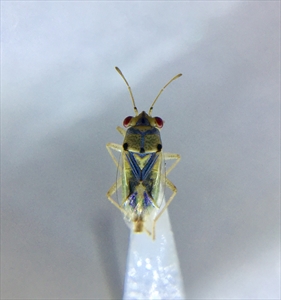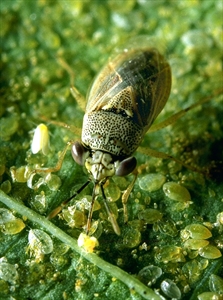- Worldwide distribution. Reported from Australia and Fiji. Prey includes aphids, hoppers, mirids, mealybugs, thrips, whiteflies, small caterpillars, and spider mites. Prey is stabbed, enzymes injects, contents sucked out.
- Eggs laid singly, or in clusters on leaves or stems near prey.
- Biocontrol: nymphs and adults predators, surviving on nectar and pollen (and seeds) when prey scarce.
- Adults, 5-6 mm long, broad heads, bulging eyes, piercing-sucking mouth parts, forewings create triangular pattern when closed.
- Management: studies in USA used crimson clover or vetch cover crops interplanted with cash crops - bugs migrate to cash crop as cover crop dies; plant sunflower to support bugs with seed when populations low; most importantly, do not use broad-spectrum insecticides, instead preserve Geocoris populations by: (i) microbial pesticides: spinosad or Bt; (ii) botanical pesticides: neem; or (iii) pheromones (if available).
Pacific Pests, Pathogens and Weeds - Online edition
Pacific Pests, Pathogens, Weeds & Pesticides
Big-eyed bug (370)
Big-eyed bug
Geocoris species. There are at least 140 species.
AUTHOR Grahame Jackson & Mani Mua
1Information from Swaine G (1971) Agricultural Zoology in Fiji. Her Majesty's Stationery Office. London; and Mead FW (2017) Geocoris spp. Featured Creatures, Entomology & Nematology. UF/IFAS, University of Florida. (http://entnemdept.ufl.edu/creatures/beneficial/bigeyed_bugs.htm); and Geocoris spp. Biological control. Cornell University, College of Agriculture and Life Sciences. (https://biocontrol.entomology.cornell.edu/predators/Geocoris.php); and from Hooks CR et al. Big-eyed bug: A MVP of generalist natural enemies. Department of Entomology, University of Maryland. (https://extension.umd.edu/sites/extension.umd.edu/files/_docs/programs/mdvegetables/Geocoris.pdf). Photo 2 Jack Dykinga, ARS image gallery, USDA.
Produced with support from the Australian Centre for International Agricultural Research under project HORT/2016/185: Responding to emerging pest and disease threats to horticulture in the Pacific islands, implemented by the University of Queensland and the Secretariat of the Pacific Community.





